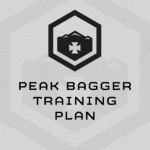
By Rob Shaul
I built the Peak Bagger Training plan specifically for 1-2 day, not technical peak bagging missions/ascents such as a Colorado 14er, the Grand Teton, or similar peaks. This is also a great plan for a Rim-to-Rim run of the Grand Canyon or any similar push with significant vertical ascent and descent. Over the years it has become one of our most effective and popular plans on the mountain athlete side.
This is a limited-equipment plan – and can be utilized to train without access to fully-equipped gym, bunches of equipment, and/or personnel who have little lifting experience.
This 6-week long, 5 day/week training plan is designed to be completed directly before your trip and will train you specifically for the specific fitness demands of peak bagging:
Uphill Hiking Under Load
Most peak bagging trips are fairly light loaded – 25-40 pound pack, but still involve significant vertical gain. Uphill hiking under load is it’s own specific “mode” of aerobic fitness and this plan uses our Step Up exercise to train it for your trip.
 Eccentric Leg Strength for the Downhill
Eccentric Leg Strength for the Downhill
Downhill hiking is actually more stressful on your legs and quads than uphill hiking. With each step, gravity tries to force you into the mountain, and your muscles work to absorb and counter this stress. In doing so they deploy “eccentric” strength” which is the opposite of the “concentric” strength you’ll use hiking uphill. This plan trains eccentric strength with our Leg Blaster complex.
Mid-Section Strength and Strength Endurance
Carrying a pack up and down the mountain takes mid-section strength and strength endurance. In this training plan you’ll be doing step ups and rucking with a pack to build transferable strength endurance. We use Sandbag Getups to build pure midsection strength.
 Calve Strength and Strength Endurance
Calve Strength and Strength Endurance
One of the first muscles to fatigue when climbing steep hills is the calf muscles. We use the interval calve raises help strengthen your calves. Our Calve Raise Intervals are 20 seconds continuous, rapid calf raises, unloaded, for 20 seconds, followed by 10 seconds in a holding “rest” position up on your toes (it’s really not a “rest.”)
Movement Over Ground Endurance
In addition to step ups, you’ll be rucking (hiking/running with a pack) and running unloaded over flat or hilly terrain to build overall aerobic endurance.
Common Questions
How long should the training sessions take?
Each training session has a listed estimated completion time objective. Tuesday and Thursday sessions are 2-a-days, – you’ll train in the morning, and again in the afternoon/evening.
Here are your estimated total training hours by week:
Week Training Hours (Approx.)
1 7
2 7.5
3 8
4 8.5
5 9
6 10
What Equipment is Required?
- Dumbbells – 25# men, 15# women.
- Sandbag – 60# Men, 40# women. You can purchase a sandbag from the mountainathlete.com website
- store, or build your own out of an old duffle bag.
- 16-19” Box, bench, stool or whatever for step ups. We build our own step up benches.
- 25# Backpack for step ups and rucking. Any filler can be used for weight.
- Something to do pullups from – pull up bar, ceiling joist, tree branch, rings, etc.
Does this plan also train the upper body?
Yes – we use bodyweight push ups and pull ups for upper body strength training in this plan.
Can I see sample training?
Click HERE and hit “Sample Training” to see the entire first week of programming.
STAY UPDATED
Sign-up for our BETA newsletter. Training tips, research updates, videos and articles - and we’ll never sell your info.
